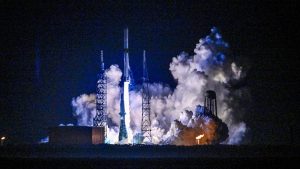NASA’s new mission could change how we mine resources on the Moon

NASA’s Polar Resources Ice Mining Experiment-1 (PRIME-1) is being prepared to analyse the Moon’s subsurface for resource extraction, with its technology expected to aid future Artemis missions. The experiment, which will assess lunar soil and identify potential resources, has been developed to support sustained human exploration. The instruments onboard will work together to drill, collect, and examine samples, providing data crucial for understanding the lunar environment. The mission is expected to deliver insights that could contribute to establishing long-term lunar habitation.
Instruments to Extract and Analyse Lunar Samples
According to the study, PRIME-1 consists of two primary instruments designed for simultaneous operation. The Regolith and Ice Drill for Exploring New Terrains (TRIDENT) has been engineered to drill into the Moon’s surface and collect samples, while the Mass Spectrometer Observing Lunar Operations (MSOLO) will analyse the gases released from these samples. Insights gained from this experiment could influence strategies for lunar resource utilisation, facilitating the production of essential supplies for deep-space missions.
Jackie Quinn, PRIME-1 project manager at NASA’s Kennedy Space Centre, stated in a report that the ability to drill and analyse samples simultaneously will provide critical information for future lunar missions. The technology is expected to assist in developing efficient methods for extracting and utilising resources available on the Moon’s surface and subsurface.
Scheduled Launch and Mission Objectives
Reports indicate that PRIME-1 is part of NASA’s Commercial Lunar Payload Services (CLPS) initiative, set to launch no earlier than February 26. The mission will be transported aboard Intuitive Machines’ Athena lunar lander, which is expected to explore the Mons Mouton plateau near the Moon’s South Pole. This location has been selected due to its potential for resource-rich deposits.
Technology Developed for Lunar Drilling and Analysis
TRIDENT, developed by Honeybee Robotics, a subsidiary of Blue Origin, has been designed as a rotary percussive drill capable of penetrating up to one metre below the lunar surface. The drill will extract 10-centimetre-long samples, allowing scientists to examine the distribution of frozen gases at varying depths. Equipped with carbide cutting teeth, the drill is built to handle the challenging lunar terrain. Unlike the Apollo-era drills, TRIDENT will be remotely operated from Earth, offering valuable data on regolith composition and temperature variations.
MSOLO, developed by INFICON and adapted for spaceflight at Kennedy Space Centre, will analyse the gases released from the drilled samples. This mass spectrometer is expected to identify the presence of water ice and other volatile compounds, contributing to a better understanding of lunar resource availability.
NASA’s CLPS Initiative and Future Exploration
Under the CLPS model, NASA is investing in commercial partnerships to enable lunar deliveries, with the goal of supporting long-term exploration. NASA, as a primary customer, is one of several organisations utilising these missions for scientific and technological advancements. The PRIME-1 mission has been funded by NASA’s Space Technology Mission Directorate Game Changing Development program and is expected to provide foundational data for future lunar operations.



